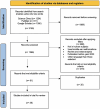A systematic review of congenital external ear anomalies and their associated factors
- PMID: 40342890
- PMCID: PMC12058720
- DOI: 10.3389/fped.2025.1520200
A systematic review of congenital external ear anomalies and their associated factors
Abstract
Objective: External ear anomalies may lead to conductive hearing loss with significant childhood disability, psychological distress, anxiety, social avoidance, and behavioral problems. The aim of this study is to compile and review published literature on the frequency of isolated and non-isolated external ear anomalies, their associated factors, and associated malformations/deformations in non-isolated cases.
Methods: We conducted a systematic review in PubMed, Google Scholar, and Science Direct searching for any type of article (excluding reviews and meta-analyses) reporting isolated and non-isolated external ear anomalies in humans. Two authors extracted the information according to the main variables of interest according to PICO criteria. Details of studied population and main findings were also obtained (malformation type, unilateral or bilateral malformations and associated factors).
Results: Twenty-six studies met eligibility criteria to be included in this review. Anotia/microtia was the most reported malformation, more frequently found in males, mostly unilateral; being the right ear the most affected, and more frequent in Hispanic population. Associated factors for external ear anomalies included parental age, maternal education, multiple pregnancies, high maternal body mass index and diabetes, pregnancy, and perinatal complications (low birth weight, prematurity, threatened abortion, etc.), twining, and chemical/drug exposure. The most reported malformations and syndromes associated with congenital external ear defects included: skull/face anomalies, cleft lip/palate, congenital heart defects, musculoskeletal malformations of skull, face and jaw, Treacher-Collins, OAVS (oculo-auriculo-vertebral spectrum), and trisomy 18, 13 and 21.
Conclusion: Congenital external ear anomalies can occur isolated or associated with other malformations or syndromes. Environmental, socioeconomic, and cultural factors may partially explain the variation across populations for congenital external ear anomalies. Depending on their type and severity, they can lead to speech impediments and childhood disability, particularly in bilateral cases, highlighting the relevance of early detection and repair to avoid childhood disability.
Keywords: auricle; congenital malformations; ear anomalies; external ear; review.
© 2025 Acosta-Rodríguez, Reza-López, Aguilar-Torres, Hinojos-Gallardo and Chávez-Corral.
Conflict of interest statement
The authors declare that the research was conducted in the absence of any commercial or financial relationships that could be construed as a potential conflict of interest.
Figures
Similar articles
-
Congenital Auricular Malformations: Description of Anomalies and Syndromes.Facial Plast Surg. 2015 Dec;31(6):567-80. doi: 10.1055/s-0035-1568139. Epub 2015 Dec 14. Facial Plast Surg. 2015. PMID: 26667631 Review.
-
[Epidemiology of orofacial clefts (1995-2006) in France (Congenital Malformations of Alsace Registry)].Arch Pediatr. 2012 Oct;19(10):1021-9. doi: 10.1016/j.arcped.2012.07.002. Epub 2012 Aug 24. Arch Pediatr. 2012. PMID: 22925539 French.
-
Oculo-auriculo-vertebral spectrum: clinical and molecular analysis of 51 patients.Eur J Med Genet. 2015 Sep;58(9):455-65. doi: 10.1016/j.ejmg.2015.07.003. Epub 2015 Jul 20. Eur J Med Genet. 2015. PMID: 26206081
-
Syndromic ear anomalies and renal ultrasounds.Pediatrics. 2001 Aug;108(2):E32. doi: 10.1542/peds.108.2.e32. Pediatrics. 2001. PMID: 11483842
-
[Microtia: isolated defect of hearing organ, or syndrome forming collection of abnormalities].Otolaryngol Pol. 2008;62(5):639-42. doi: 10.1016/S0030-6657(08)70332-9. Otolaryngol Pol. 2008. PMID: 19004275 Review. Polish.
References
-
- Thorn L. Entwicklung des ohres (einschließlich entstehung von missbildungen, experimentelle embryologie und in vitro-studien). In: Helms J, editor. Oto-Rhino-Laryngologie in Klinik und Praxis. Stuttgart: Thieme; (1994). Vol. 1. p. 1–22.
-
- Tewfik T, Teebi A, Der Kaloustian V. Apendix A. Syndromes and conditions associated with congenital anomalies of the ear. In: Tewfik TL, der Kaloustian VM, editors. Congenital Anomalies of the ear, Nose, and Throat. New York, NY: Oxford University Press; (1997). p. 125–44.
Publication types
LinkOut - more resources
Full Text Sources
Miscellaneous


